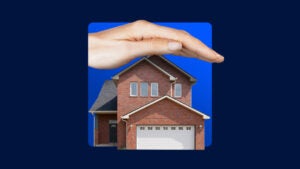HO-2 homeowners insurance policies




Key takeaways
- An HO-2 policy is a type of homeowners insurance that only covers damages caused by perils specifically named in your policy.
- An HO-2 typically covers 16 named perils, including damage from fire and lightning, windstorms and hail, and theft.
- HO-2 policies may be cheaper since they offer less coverage, but you may be opening yourself up to extra risk.
HO-2 insurance, also known as a broad form homeowners insurance policy, is a type of coverage designed to protect homeowners from specific perils. A step up from HO-1 policies, an HO-2 policy offers more extensive protection by covering not only the structure of the home but also personal belongings and additional living expenses if the home becomes uninhabitable due to a covered event. With an HO-2 insurance policy, homeowners are financially safeguarded against specific perils ranging from fire and theft to falling objects and storm damage. These policy types are, however, limited to the perils named in the policy, so they could leave you open to greater financial risk. Bankrate can help you parse the specifics of HO-2 insurance so you can understand the potential benefits and pitfalls and ensure you have the comprehensive financial protection you need.
What is HO-2 insurance?
There are four different types of insurance available for traditional homeowners: HO-1, HO-2, HO-3 and HO-5. Each policy type offers varying levels of protection, and plans with more robust protection tend to cost more. An HO-1 policy offers the lowest levels of protection. On the other end of the spectrum is the HO-5 policy, which gives you the most protection of the various coverage forms. However, either policy type typically comes with requirements your home has to meet.
HO-2 policies are a step up from HO-1 policies, but do not offer as much coverage as an HO-3, which is the most common type of homeowners insurance policy. Like other home insurance policies, HO-2 insurance is comprised of several standard coverage types, including:
- Dwelling coverage: Covers the home’s structure, such as the roof, walls, foundation and any attached items, like a deck or garage.
- Other structures coverage: Covers detached structures like sheds, fences, detached garages and in-ground swimming pools.
- Personal property coverage: Covers your belongings, such as clothes, furniture and electronics.
- Liability coverage: Provides financial protection if you are found at fault for injuries or damage to someone’s belongings that occurs on your property
- Additional living expenses coverage: Provides temporary living coverage in case your home is not liveable due to a covered loss
HO-2 vs. HO-3 policies
The main difference between most home insurance policies is not what they cover, but rather how they cover your property. In home insurance, unforeseen damaging events are known as perils. The various components of home insurance policies are covered either on a named perils basis or an open perils basis. In general, named perils will cover only perils, such as fire or wind, specifically named in your policy. An open perils policy protects you against any loss unless the peril is explicitly listed as an exclusion, such as damage caused by flooding or earthquakes.
An HO-2 insurance policy covers homeowners on a named perils basis. This means that your policy will only cover damage to your home, detached structures and personal property caused by a peril that is specifically listed in the policy. If your home is damaged by an occurrence that is not specifically listed, it will not be covered. An HO-3 policy, on the other hand, offers broader protection by protecting your dwelling and other structures on an open peril basis:
| HO-2 coverage type | HO-3 coverage type | |
|---|---|---|
| Dwelling | Named perils | Open perils |
| Other structures | Named perils | Open perils |
| Contents | Named perils | Named perils |
Additionally, most HO-3 home insurance policies include some level of medical payments coverage, which helps if a guest is injured in your home. HO-2 policies do not usually include this type of coverage.
HO-2 coverage
Now that you know that an HO-2 policy only covers specifically named losses, you may be wondering exactly which perils HO-2 policies cover. An HO-2 policy typically lists 16 named perils, including:
- Fire and lightning
- Windstorm and hail
- Explosions
- Riot and civil commotion
- Damage caused by aircraft
- Damage caused by vehicles
- Smoke
- Vandalism
- Theft
- Volcanic eruption
- Falling objects
- Damage caused by the weight of ice, snow or sleet
- Accidental discharge of water or steam from a household appliance or a plumbing, heating, air conditioning or sprinkler system
- Sudden and accidental tearing apart, cracking, burning or bulging of a steam or hot water heating system, air conditioner or sprinkler system
- Freezing of a household appliance or plumbing, heating, air conditioner or sprinkler system
- Sudden and accidental damage from an artificially generated electrical current
What do HO-2 policies exclude?
Like most home policies, HO-2 insurance typically does not cover flood and earthquake damage. Other exclusions may include:
- Water damage caused by sewer or drain backups
- Nuclear accidents
- Acts of war
- Mudslides and landslides
- Sinkholes
- Mold
- Pests like rodents or termites
- Property damage caused by pets
- Power failure
- Damage as a result of neglected maintenance
- Intentionally inflicted damage
Some homeowners insurance providers offer the ability to add optional coverage types to your policy with riders, also called endorsements. You might be able to add a rider to cover mold damage or sewer backup damage, for example. Coverage for flood and earthquake damage could also be added as endorsements, if offered, or you may need to purchase separate policies for these damages.
Frequently asked questions
-
-
You can buy HO-2 insurance from most home insurance companies directly or from local insurance agencies and online insurance platforms. Major insurers often offer free online quotes and the option to complete your purchase online. If you prefer a face to face experience, local insurance agents can provide personalized service and help tailor the policy to fit your specific needs. Additionally, insurance comparison websites can help you compare HO-2 insurance options from multiple providers to find the best coverage and rates.
-
The price of an HO-2 policy, as with all types of home insurance, hinges on a variety of factors. These include your home’s age, its unique features, your geographic location and the frequency of natural disasters in your region. To ensure you select a budget-friendly option, it’s recommended to gather and compare quotes from several insurance providers.
For perspective, as of May 2024, the average cost of home insurance in the United States is approximately $2,153 per year for $300,000 in dwelling coverage (for an HO-3 policy). Comparing HO-2 policy quotes against the average insurance cost of home insurance in your state won’t be apples to apples, but it could help you make a more informed decision about whether an HO-2 or HO-3 policy is right for you.
-
Generally, policies that offer less protection — like HO-1 and HO-2 insurance — are cheaper than policies with more expansive coverage options. You may pay less, but you will also be exposed to more financial risk.
If you are unsure how much coverage you need, talking to an insurance professional may be a good idea. An agent can help you evaluate your specific needs and guide you to a policy that provides the best financial protection for your unique situation.
-
There are several perils not named on an HO-2 policy that are also excluded on an HO-3 policy. Perils that are typically not covered by either policy include earthquakes, floods, mudslides, war and owner neglect. If you want these perils covered, you may need to purchase additional coverage. Some perils may not be covered by any provider, but talking with an insurance agent could help you determine if coverage is available.
-
That depends on your priorities. If you are looking to save money on your premium, you might find that an HO-2 policy is better suited for your needs. However, it’s something of a double-edged sword: if you choose an HO-2 insurance policy to save money, you could wind up paying thousands more out of pocket if your home sustains damage from something other than a named peril. An HO-3 policy offers you broader protection from a wider selection of perils, but the added protection will likely come with a higher premium. If you’re debating between the two policy types, it may be worthwhile to set aside some time to chat with a licensed agent.
-
You may also like

New York flood insurance: how to get coverage and how much it costs

Guide to home insurance: coverage basics and definitions

Benefits of independent insurance agents

Should you return a partial payout from a home insurance claim?
